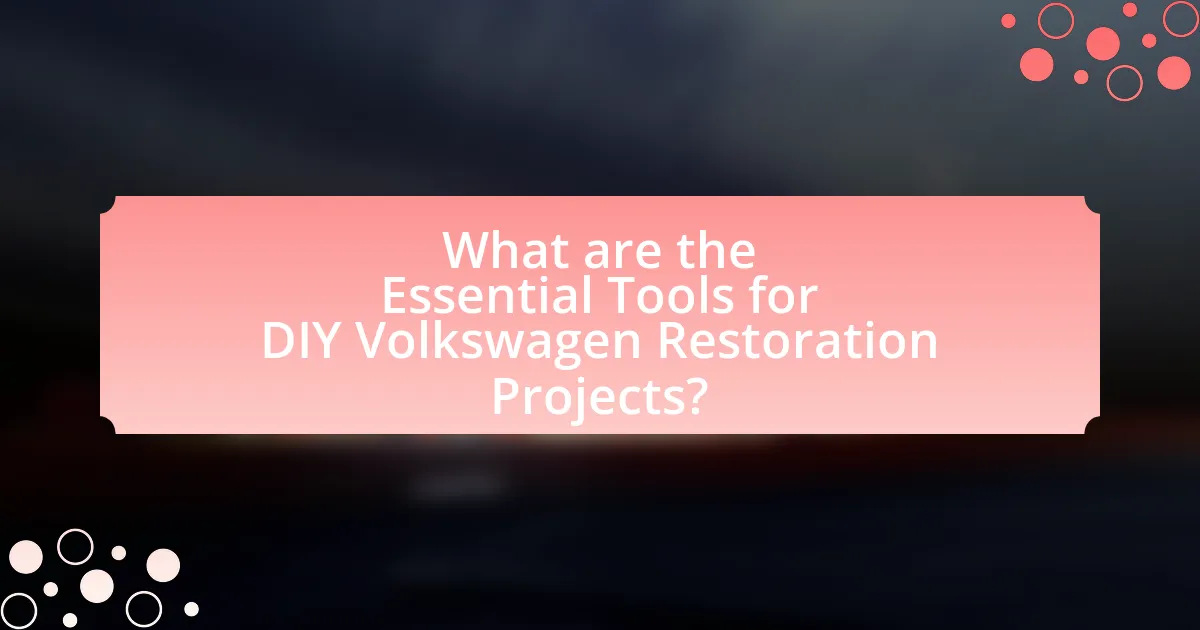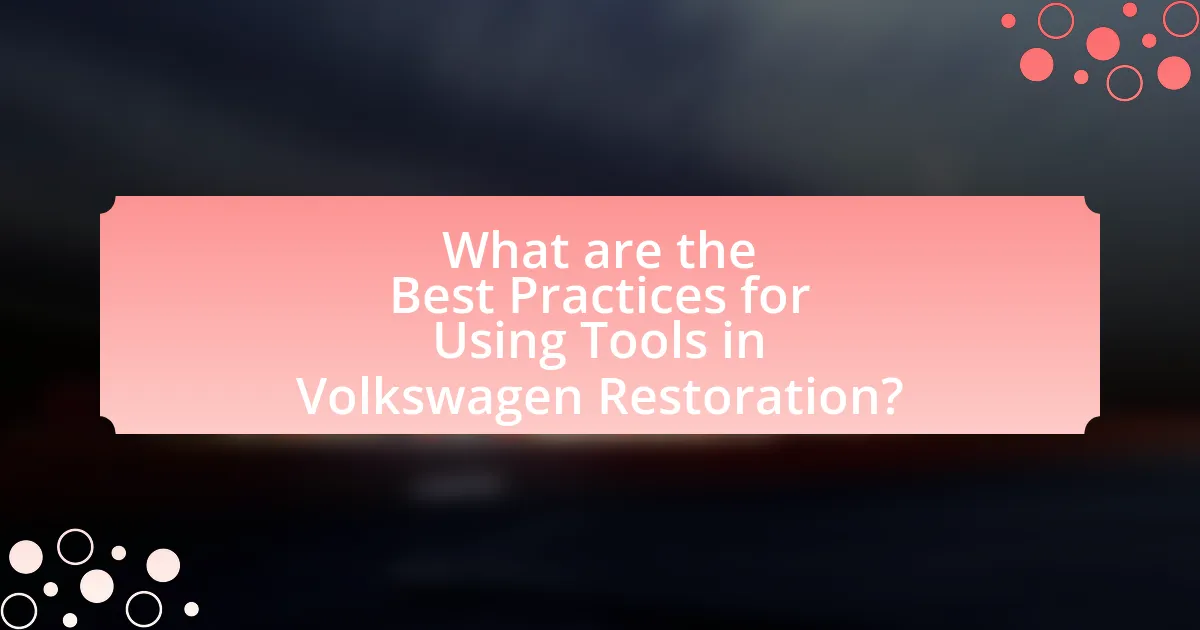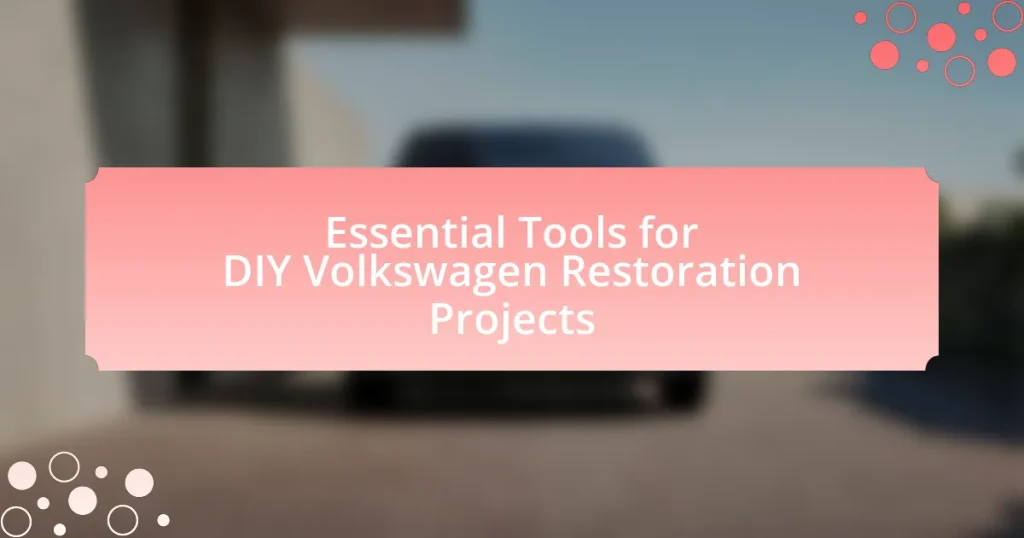The article focuses on the essential tools required for DIY Volkswagen restoration projects, emphasizing the importance of having a comprehensive set of hand tools, power tools, and specialized equipment. Key categories of tools discussed include hand tools like wrenches and screwdrivers, power tools such as drills and sanders, and specialized tools unique to Volkswagen vehicles. The article highlights the challenges faced by DIY restorers without the proper tools, the benefits of using the right equipment, and best practices for tool maintenance and safety. Additionally, it provides troubleshooting tips for common tool issues and resources for restorers seeking advice on tool selection and usage.

What are the Essential Tools for DIY Volkswagen Restoration Projects?
The essential tools for DIY Volkswagen restoration projects include a comprehensive set of hand tools, power tools, and specialized equipment. Hand tools such as wrenches, screwdrivers, pliers, and hammers are crucial for disassembly and assembly tasks. Power tools like drills, grinders, and sanders facilitate efficient work on metal and bodywork. Additionally, specialized tools such as a Volkswagen-specific repair manual, a jack and jack stands for lifting the vehicle, and a welding machine for body repairs are vital. These tools enable restorers to effectively manage various aspects of the restoration process, ensuring precision and quality in the final outcome.
Why is having the right tools important for Volkswagen restoration?
Having the right tools is crucial for Volkswagen restoration because they ensure precision, efficiency, and safety during the restoration process. Proper tools allow restorers to effectively disassemble, repair, and reassemble components without causing damage, which is particularly important given the age and unique design of Volkswagen vehicles. For instance, specialized tools like torque wrenches and panel alignment tools help maintain the integrity of the vehicle’s structure and mechanical systems. Additionally, using the correct tools minimizes the risk of injury and enhances the overall quality of the restoration, leading to a more reliable and aesthetically pleasing final product.
What specific challenges do DIY restorers face without proper tools?
DIY restorers face significant challenges without proper tools, including inefficiency, increased risk of damage, and compromised quality of work. Inefficiency arises as tasks take longer to complete without specialized tools, leading to frustration and potential project abandonment. The risk of damage is heightened, as using inappropriate tools can result in harm to the vehicle’s components, which may lead to costly repairs. Additionally, the quality of restoration suffers, as precision and accuracy are often unattainable without the right equipment, ultimately affecting the vehicle’s performance and aesthetic appeal. These challenges underscore the importance of having the necessary tools for successful DIY restoration projects.
How can the right tools enhance the restoration process?
The right tools significantly enhance the restoration process by improving efficiency, precision, and quality of work. For instance, specialized tools like torque wrenches ensure that bolts are tightened to the correct specifications, preventing damage and ensuring safety. Additionally, using high-quality paint sprayers can lead to a smoother finish, reducing the need for extensive sanding and rework. Studies show that projects utilizing appropriate tools can reduce completion time by up to 30%, demonstrating the impact of tool selection on overall productivity and outcome quality in restoration tasks.
What categories of tools are essential for Volkswagen restoration?
Essential categories of tools for Volkswagen restoration include hand tools, power tools, bodywork tools, and diagnostic tools. Hand tools such as wrenches, screwdrivers, and pliers are necessary for disassembly and assembly of components. Power tools like drills, grinders, and sanders facilitate efficient material removal and surface preparation. Bodywork tools, including hammers, dollies, and welding equipment, are crucial for repairing and reshaping metal parts. Lastly, diagnostic tools such as multimeters and OBD-II scanners help in troubleshooting electrical and mechanical issues. These categories encompass the fundamental tools required to effectively restore a Volkswagen vehicle.
What hand tools should every DIY restorer have?
Every DIY restorer should have a set of essential hand tools, including a screwdriver set, pliers, wrenches, a hammer, and a utility knife. These tools are fundamental for various tasks such as disassembly, assembly, and general repairs. A screwdriver set allows for the removal and installation of screws, while pliers provide grip and leverage for bending or cutting wires. Wrenches are crucial for loosening and tightening nuts and bolts, and a hammer is necessary for driving nails or adjusting parts. A utility knife is versatile for cutting materials like tape or cardboard. Collectively, these tools form the backbone of any restoration project, ensuring that restorers can effectively manage the various challenges they encounter.
Which power tools are most beneficial for Volkswagen projects?
The most beneficial power tools for Volkswagen projects include an impact wrench, a rotary tool, and a power sander. An impact wrench is essential for quickly loosening and tightening bolts, especially in suspension and engine work, where high torque is required. A rotary tool is versatile for cutting, grinding, and polishing, making it ideal for detailed work on body panels and interior components. A power sander is crucial for achieving a smooth finish on surfaces before painting or refinishing, which is vital in restoration projects. These tools enhance efficiency and precision, ensuring high-quality results in Volkswagen restoration tasks.
What specialized tools are unique to Volkswagen restoration?
Specialized tools unique to Volkswagen restoration include the VW-specific tool kit, which features items like the 36mm axle nut socket, a dual-port engine case wrench, and a valve adjustment tool. These tools are designed to accommodate the unique specifications and components of Volkswagen vehicles, particularly classic models like the Beetle and Bus. For instance, the 36mm axle nut socket is essential for removing and installing the axle nuts on these vehicles, which are not standard sizes found in general tool kits. Additionally, the dual-port engine case wrench allows for easier access to engine components during rebuilds, ensuring that restorers can work efficiently and effectively on Volkswagen engines.
How can one choose the best tools for their Volkswagen restoration project?
To choose the best tools for a Volkswagen restoration project, one should assess the specific needs of the restoration, including the model and condition of the vehicle. Identifying essential tools such as wrenches, screwdrivers, and specialized Volkswagen parts tools is crucial, as these directly impact the efficiency and quality of the restoration process. Researching tool reviews and recommendations from experienced restorers can provide insights into the most effective tools available. Additionally, considering the budget and availability of tools, including both new and used options, can help in making informed decisions.
What factors should be considered when selecting tools?
When selecting tools for DIY Volkswagen restoration projects, consider compatibility, quality, and ergonomics. Compatibility ensures that the tools work effectively with Volkswagen parts and systems, which is crucial for achieving desired results. Quality is essential as high-quality tools tend to be more durable and reliable, reducing the likelihood of failure during critical tasks. Ergonomics plays a significant role in user comfort and efficiency, as tools that are easy to handle can enhance productivity and reduce fatigue during long restoration sessions.
How does budget impact tool selection for restoration projects?
Budget significantly impacts tool selection for restoration projects by determining the quality and quantity of tools that can be purchased. A limited budget may necessitate the choice of lower-cost, potentially lower-quality tools, which can affect the efficiency and effectiveness of the restoration process. For instance, investing in high-quality tools can lead to better results and longer tool lifespan, ultimately saving money in the long run. Conversely, a larger budget allows for the acquisition of specialized tools that enhance precision and reduce labor time, thereby improving overall project outcomes.

What are the Best Practices for Using Tools in Volkswagen Restoration?
The best practices for using tools in Volkswagen restoration include ensuring proper tool selection, maintaining tools in good condition, and following safety protocols. Proper tool selection is crucial; using the right tools for specific tasks, such as wrenches for bolts and screwdrivers for screws, enhances efficiency and prevents damage. Maintaining tools involves regular cleaning, lubrication, and inspection for wear, which prolongs their lifespan and ensures optimal performance. Following safety protocols, such as wearing protective gear and using tools according to manufacturer instructions, minimizes the risk of accidents and injuries during restoration projects. These practices are supported by industry standards that emphasize safety and efficiency in automotive restoration.
How can one ensure safety while using restoration tools?
To ensure safety while using restoration tools, one must always wear appropriate personal protective equipment (PPE) such as gloves, goggles, and masks. This equipment protects against potential hazards like sharp edges, flying debris, and harmful dust or fumes. Additionally, it is crucial to read and follow the manufacturer’s instructions for each tool, as these guidelines provide essential safety information specific to the equipment being used. According to the Occupational Safety and Health Administration (OSHA), proper training and awareness of tool operation significantly reduce the risk of accidents, emphasizing the importance of understanding how to handle each tool safely.
What safety gear is recommended for DIY restorers?
DIY restorers are recommended to use safety gear that includes safety goggles, gloves, a dust mask or respirator, and ear protection. Safety goggles protect the eyes from debris and harmful chemicals, while gloves safeguard the hands from cuts and exposure to hazardous materials. A dust mask or respirator is essential for filtering out harmful particles and fumes, especially when sanding or painting. Ear protection is important to prevent hearing damage from loud tools. These safety measures are crucial for minimizing risks associated with restoration projects, ensuring a safer working environment.
What common safety mistakes should be avoided during restoration?
Common safety mistakes to avoid during restoration include neglecting personal protective equipment (PPE), failing to properly ventilate workspaces, and overlooking electrical safety protocols. Neglecting PPE, such as gloves, goggles, and masks, increases the risk of injury from chemicals and sharp objects. Proper ventilation is crucial when working with paints and solvents to prevent inhalation of harmful fumes. Additionally, not following electrical safety guidelines can lead to shocks or fires, especially when working with older vehicles that may have outdated wiring. These mistakes can significantly compromise safety and lead to serious accidents.
What maintenance practices should be followed for restoration tools?
Restoration tools should be regularly cleaned, inspected for damage, and properly stored to ensure longevity and effectiveness. Cleaning involves removing debris, rust, and any residue after each use, which prevents corrosion and maintains functionality. Regular inspections help identify wear and tear, allowing for timely repairs or replacements, thus avoiding potential project delays. Proper storage in a dry, organized environment protects tools from environmental damage and makes them easily accessible for future use. Following these maintenance practices enhances the performance and lifespan of restoration tools, which is crucial for successful DIY Volkswagen restoration projects.
How can regular maintenance extend the life of tools?
Regular maintenance can significantly extend the life of tools by preventing wear and tear, ensuring optimal performance, and reducing the likelihood of breakdowns. For instance, routine cleaning removes debris and rust, which can corrode metal parts, while lubricating moving components minimizes friction, thereby prolonging their functionality. Studies indicate that tools subjected to regular maintenance can last up to 50% longer than those that are neglected, highlighting the importance of consistent care in preserving tool integrity and efficiency.
What cleaning techniques are effective for different types of tools?
Effective cleaning techniques for different types of tools include using solvent-based cleaners for metal tools, soap and water for plastic tools, and vinegar or baking soda for rust removal. Metal tools benefit from solvent-based cleaners, which dissolve grease and grime without damaging the surface. Plastic tools can be cleaned with a mixture of soap and water, ensuring they remain intact and free from scratches. For rusted metal tools, vinegar or baking soda can effectively remove rust due to their acidic properties, restoring the tool’s functionality. These methods are widely recognized in maintenance practices for their efficiency and safety.

What are Common Troubleshooting Tips for DIY Volkswagen Restoration Tools?
Common troubleshooting tips for DIY Volkswagen restoration tools include checking for proper tool calibration, ensuring that all components are compatible, and inspecting for wear and tear. Proper calibration is essential as it ensures accuracy in measurements, which is critical for restoration tasks. Compatibility among tools and parts prevents issues during assembly and operation. Additionally, inspecting tools for wear can prevent malfunctions that could lead to project delays or safety hazards. Regular maintenance and cleaning of tools also contribute to their longevity and effectiveness in restoration projects.
What issues might arise with restoration tools during a project?
Restoration tools may encounter issues such as malfunction, compatibility problems, and inadequate performance during a project. Malfunction can occur due to wear and tear or improper maintenance, leading to delays and increased costs. Compatibility problems arise when tools do not fit or work well with specific Volkswagen parts, which can hinder progress. Inadequate performance may result from using low-quality tools, causing inefficiencies and potential damage to the vehicle. These issues can significantly impact the overall success and timeline of a restoration project.
How can one troubleshoot power tool malfunctions?
To troubleshoot power tool malfunctions, one should first identify the specific issue by checking for common problems such as power supply, damaged cords, or worn-out components. For instance, ensuring the tool is plugged in and the outlet is functional can resolve many issues. Additionally, inspecting the tool for visible damage or obstructions can help pinpoint the malfunction. Regular maintenance, including cleaning and lubricating moving parts, can prevent future problems. According to the National Institute for Occupational Safety and Health, proper maintenance can extend the life of power tools and reduce the likelihood of malfunctions.
What should be done if hand tools become damaged or ineffective?
If hand tools become damaged or ineffective, they should be repaired or replaced immediately to ensure safety and efficiency during restoration projects. Damaged tools can lead to accidents or subpar work quality, which is critical in DIY Volkswagen restoration. For instance, a worn-out wrench may slip and cause injury or damage to components. Regular inspections and maintenance can help identify issues early, allowing for timely repairs or replacements.
What are some final tips for successful Volkswagen restoration projects?
To ensure successful Volkswagen restoration projects, prioritize thorough planning and research. Understanding the specific model’s requirements and sourcing quality parts are crucial steps. Additionally, maintaining a detailed project timeline helps manage tasks effectively and keeps the restoration on track. Utilizing the right tools, such as a quality socket set, torque wrench, and specialized Volkswagen tools, enhances efficiency and accuracy during the restoration process. Engaging with online communities or local clubs can provide valuable insights and support, further increasing the likelihood of a successful outcome.
How can planning and organization improve the restoration process?
Planning and organization significantly enhance the restoration process by ensuring efficient resource allocation and minimizing errors. A well-structured plan allows restorers to outline necessary tasks, timelines, and required materials, which streamlines workflow and reduces downtime. For instance, a study by the Project Management Institute indicates that projects with clear planning are 20-30% more likely to be completed on time and within budget. This structured approach not only helps in tracking progress but also facilitates better decision-making, ultimately leading to a more successful restoration outcome.
What resources are available for DIY restorers seeking tool advice?
DIY restorers seeking tool advice can utilize online forums, instructional videos, and specialized websites dedicated to restoration projects. Websites like TheSamba.com and VWVortex.com offer community-driven discussions and expert insights specifically for Volkswagen restorations. Additionally, YouTube hosts numerous channels that provide visual guidance on tool usage and restoration techniques. These resources are validated by the active participation of experienced restorers who share their knowledge and practical tips, making them reliable for DIY enthusiasts.


